Spatio-Seasonal Hypoxia/Anoxia Dynamics and Sill Circulation Patterns Linked to Natural Ventilation Drivers, in a Mediterranean Landlocked Embayment: Amvrakikos Gulf, Greece
Abstract
1. Introduction
1.1. Regional Settings
1.2. Oceanographic Setting
2. Materials, Methods and Survey Design
2.1. Statistical Treatment
2.1.1. Data Correction and Interpolation
2.1.2. Water Volume and Bottom Area DO Metrics
2.1.3. Factor Analysis
3. Results
3.1. Water Circulation Patterns at the Sill
3.1.1. Preveza Strait Water Circulation
- Upper unit (0–7 m): (Figure 2A)
- Intermediate unit (7–12 m): (Figure 2B)
- Lower unit (12 m to the seafloor) (Figure 2C)
3.1.2. A Time-Lapse of Tide-Driven Bottom Seawater Intrusion in April
3.1.3. Seawater Mixing and Intrusion through the Mid-Water in November
3.2. Natural Forcing
3.3. Seasonal Spatio-Temporal DO Distribution Patterns and Quantification
- June to September: The summer period was characterized by the lowest density differences (less than 2 kg/m3) and the seawater intrusion was very limited, affecting mostly the sill. The water column was hypoxic below 18 m and anoxic below 22 m depth. Stratification was not very enhanced; the upper part of the water column reached up to 7 mg/L of DO and had a salinity of 30–33 PSU, and the density ranged from 20–22 kg/m3 (Figure 6G,J,M). Below a depth of 10 m, the salinity was greater than 36 PSU and homogeneously distributed, and the density was greater than 25 kg/m3. The denser water was mainly detected in Basin D (27.8 kg/m3). Hypoxia isoline presented its minimum depth at 10 and 11 m in Basins C and B, respectively (Figure 6A). It is worth noting that the DO at the seabed close to Louros River had a high value of 4 mg/L (Figure 6D). The biggest part of the gulf’s seabed was anoxic apart from Preveza Strait and part of the Preveza Gulf.
- October to January: During the fall–winter period density difference ranged between 1.4 and 2.5 kg/m3, respectively, and ventilation of the water column happened through the mid-water at depths between 10 and 25 m. The mid-water oxygenation reached Basin B (Figure 6H). Apart from the Preveza Gulf seabed, the rest of Amvrakikos Gulf’s bottom was anoxic (Figure 6E). The 2 mg/L oxygen isoline in this period was higher at the E and SE part of the gulf as it reached a depth of 11 m and 8 m, respectively, whereas at the W part it was found at 12 m depth (Figure 6B). The seawater of salinity > 37 PSU spread at the bottom of Preveza Gulf, and it covered the mid-water of Basin A. In the rest of the gulf, the water column at depths from 15 to 25 m had a salinity of 36.5 PSU, and dropped to 36 PSU below 25 m (Figure 6K). The density at the upper part of the water column ranged from 20 to 23 kg/m3, whereas from a depth of 10 m to the bottom it varied from 24 to 27 kg/m3.
- February to May: It was observed that during the winter–spring period, maximum oxygenation of the seabed occurred. Ventilation happened from the bottom part of the water column (20 m to the seafloor) (Figure 6I). Preveza Gulf and Basins A and B were very well oxygenated (5–8 mg/L) (Figure 6F,I). Regarding Basin D, this was the only period that it was oxygenated and became partly hypoxic (1.6 mg/L). The hypoxia interface was recorded at a minimum depth of 8 m in the east, whereas it remained under 10 m in the rest of the Gulf (Figure 6C). The water column was highly stratified and the salinity, which at the upper part presented a minimum of 24 PSU, quickly reached 36.5 PSU at 10 m depth. The salinity at the mouth of the gulf presented a maximum of 39 PSU, whereas at the bottom it had a maximum salinity of 37 PSU. Density also fluctuated from 15 kg/m3 at the top to 26–27 kg/m3 at the bottom, and it presented a maximum of 29 kg/m3 at the mouth of the gulf.
3.4. Weighting Natural Forcing Contribution—Factor Analysis
3.5. Geomorphology and Site-Specific Dynamics
4. Discussion
5. Conclusions
- An almost permanent two-layered fjord estuarine circulation pattern at the sill (top brackish outflow–bottom seawater inflow) appeared to be dynamically controlled seasonally by the density differences between Amvrakikos Gulf and the Ionian Sea and daily by the tide fluctuation.
- Natural seasonal ventilation of the gulf is mainly controlled by the density difference between the Ionian Sea and Amvrakikos Gulf, and by riverine inflows, wind, and the geomorphology of the seabed. The complex geomorphology of the gulf, with well-formed internal basins, contributes to the development and preservation of low DO conditions, especially in the eastern and larger basin D. Statistical analyses on the estimated annual variations in anoxic/hypoxic water volumes showed that the main driver that shrinks anoxia and oxygenates the gulf’s seabed is the horizontal density gradient, whereas diffusive processes and vertical mixing (e.g., riverine inflow and wind mixing) were oxygenated more effectively in the volume and bottom areas above or within the pycnocline range that had a DO concentration greater than 2 mg/L.
- The bottom hypoxic stagnant mass expands upwards during the winter–spring period and reaches the limit of the pycnocline at a depth of at least 8 m in the east (Basin D) and 10 m in the west (Basin C) of the gulf, where the farmed fish accidents happened. This phenomenon, together with persistent strong winds (E or W) in winter, is likely to have triggered upwelling processes and bring the hypoxic mass up to the surface, leading to massive mortalities, especially in fish farms.
- A total of 43% of the Amvrakikos Gulf seafloor is hypoxic throughout the year and during the summer–autumn period it increases up to 70%, whereas 50% of the seafloor becomes anoxic. A total of 36% of the total water volume contained in the gulf is permanently hypoxic and 10% anoxic, and increases to 62% and 40%, respectively, during the summer–autumn stagnation period. A total of 85% of the stagnant bottom saline mass that is contained within the gulf and lies under the brackish water is hypoxic throughout the year. The eastern part sustains anoxia almost the entire year, and in the rest of the Gulf for almost half of the year.
Supplementary Materials
Author Contributions
Funding
Acknowledgments
Conflicts of Interest
References
- Barnes, R.S.K. Coastal Lagoons; CUP Archive: Cambridge, UK, 1980; Volume 1, ISBN 0521299454. [Google Scholar]
- Costanza, R.; D’Arge, R.; De Groot, R.; Farber, S.; Grasso, M.; Hannon, B.; Limburg, K.; Naeem, S.; O’Neill, R.V.; Paruelo, J.; et al. The value of the world’s ecosystem services and natural capital. Nature 1997, 387, 253–260. [Google Scholar] [CrossRef]
- Diaz, R.J.; Rosenberg, R. Spreading Dead Zones and Consequences for Marine Ecosystems. Science 2008, 321, 926–929. [Google Scholar] [CrossRef] [PubMed]
- Dobson, A.; Lodge, D.; Alder, J.; Cumming, G.S.; Keymer, J.; McGlade, J.; Mooney, H.; Rusak, J.A.; Sala, O.; Wolters, V.; et al. Habitat loss, trophic collapse, and the decline of ecosystem services. Ecology 2006, 87, 1915–1924. [Google Scholar] [CrossRef]
- Friedrich, J.; Janssen, F.; Aleynik, D.; Bange, H.W.; Boltacheva, N.; Çagatay, M.N.; Dale, A.W.; Etiope, G.; Erdem, Z.; Geraga, M.; et al. Investigating hypoxia in aquatic environments: Diverse approaches to addressing a complex phenomenon. Biogeosciences 2014, 11, 1215–1259. [Google Scholar] [CrossRef]
- Shahidul Islam, M.; Tanaka, M. Impacts of pollution on coastal and marine ecosystems including coastal and marine fisheries and approach for management: A review and synthesis. Mar. Pollut. Bull. 2004, 48, 624–649. [Google Scholar] [CrossRef] [PubMed]
- Libralato, S.; Caccin, A.; Pranovi, F. Modeling species invasions using thermal and trophic niche dynamics under climate change. Front. Mar. Sci. 2015, 2, 29. [Google Scholar] [CrossRef]
- Díaz, R.J.; Rosenberg, R. Introduction to Environmental and Economic Consequences of Hypoxia. Int. J. Water Resour. Dev. 2011, 27, 71–82. [Google Scholar] [CrossRef]
- Halpern, B.S.; Longo, C.; Hardy, D.; McLeod, K.L.; Samhouri, J.F.; Katona, S.K.; Kleisner, K.; Lester, S.E.; O’Leary, J.; Ranelletti, M.; et al. An index to assess the health and benefits of the global ocean. Nature 2012, 488, 615–620. [Google Scholar] [CrossRef]
- Hardy, J.T. Climate Change Causes, Effects, and Solutions; John Wiley Sons Ltd.: Chichester, UK, 2003; Volume 26, pp. 139–140. [Google Scholar] [CrossRef]
- Hu, S.; Sprintall, J.; Guan, C.; McPhaden, M.J.; Wang, F.; Hu, D.; Cai, W. Deep-reaching acceleration of global mean ocean circulation over the past two decades. Sci. Adv. 2020, 6, eaax7727. [Google Scholar] [CrossRef]
- Koutsodendris, A.; Brauer, A.; Zacharias, I.; Putyrskaya, V.; Klemt, E.; Sangiorgi, F.; Pross, J. Ecosystem response to human- and climate-induced environmental stress on an anoxic coastal lagoon (Etoliko, Greece) since 1930 AD. J. Paleolimnol. 2015, 53, 255–270. [Google Scholar] [CrossRef]
- Pérez-Santos, I.; Castro, L.; Ross, L.; Niklitschek, E.; Mayorga, N.; Cubillos, L.; Gutierrez, M.; Escalona, E.; Castillo, M.; Alegría, N.; et al. Turbulence and hypoxia contribute to dense biological scattering layers in a Patagonian fjord system. Ocean Sci. 2018, 14, 1185–1206. [Google Scholar] [CrossRef]
- Ferentinos, G.; Papatheodorou, G.; Geraga, M.; Iatrou, M.; Fakiris, E.; Christodoulou, D.; Dimitriou, E.; Koutsikopoulos, C. Fjord water circulation patterns and dysoxic/anoxic conditions in a Mediterranean semi-enclosed embayment in the Amvrakikos Gulf, Greece. Estuar. Coast. Shelf Sci. 2010, 88, 473–481. [Google Scholar] [CrossRef]
- Albanis, T.A.; Danis, T.G.; Hela, D.G. Transportation of pesticides in estuaries of Louros and Arachthos rivers (Amvrakikos Gulf, N.W. Greece). Sci. Total Environ. 1995, 171, 85–93. [Google Scholar] [CrossRef]
- Avramidis, P.; Iliopoulos, G.; Panagiotaras, D.; Papoulis, D.; Lambropoulou, P.; Kontopoulos, N.; Siavalas, G.; Christanis, K. Tracking Mid- to Late Holocene depositional environments by applying sedimentological, palaeontological and geochemical proxies, Amvrakikos coastal lagoon sediments, Western Greece, Mediterranean Sea. Quat. Int. 2014, 332, 19–36. [Google Scholar] [CrossRef]
- Tsirogiannis, I.L.; Karras, G.; Tsolis, D.; Barelos, D. Irrigation and Drainage Scheme of the Plain of Arta—Effects on the Rural Landscape and the Wetlands of Amvrakikos’ Natura Area. Agric. Agric. Sci. Procedia 2015, 4, 20–28. [Google Scholar] [CrossRef][Green Version]
- Kormas, K.A.; Nicolaidou, A.; Reizopoulou, S. Temporal variations of nutrients, chlorophyll a and particulate matter in three coastal lagoons of Amvrakikos Gulf (Ionian Sea, Greece). Mar. Ecol. 2001, 22, 201–213. [Google Scholar] [CrossRef]
- Kotti, M.E.; Vlessidis, A.G.; Thanasoulias, N.C.; Evmiridis, N.P. Assessment of River Water Quality in Northwestern Greece. Water Resour. Manag. 2005, 19, 77–94. [Google Scholar] [CrossRef]
- Piroddi, C.; Moutopoulos, D.K.; Gonzalvo, J.; Libralato, S. Ecosystem health of a Mediterranean semi-enclosed embayment (Amvrakikos Gulf, Greece): Assessing changes using a modeling approach. Cont. Shelf Res. 2016, 121, 61–73. [Google Scholar] [CrossRef]
- Kountoura, K.; Zacharias, I. Temporal and spatial distribution of hypoxic/seasonal anoxic zone in Amvrakikos Gulf, Western Greece. Estuar. Coast. Shelf Sci. 2011, 94, 123–128. [Google Scholar] [CrossRef]
- Anastasakis, G.; Piper, D.J.W.; Tziavos, C. Sedimentological response to neotectonics and sea-level change in a delta-fed, complex graben: Gulf of Amvrakikos, western Greece. Mar. Geol. 2007, 236, 27–44. [Google Scholar] [CrossRef]
- Poulos, S.E.; Kapsimalis, V.; Tziavos, C.; Paramana, T. Origin and distribution of surface sediments and human impacts on recent sedimentary processes. The case of the Amvrakikos Gulf (NE Ionian Sea). Cont. Shelf Res. 2008, 28, 2736–2745. [Google Scholar] [CrossRef]
- Kapsimalis, V.; Pavlakis, P.; Poulos, S.E.; Alexandri, S.; Tziavos, C.; Sioulas, A.; Filippas, D.; Lykousis, V. Internal structure and evolution of the Late Quaternary sequence in a shallow embayment: The Amvrakikos Gulf, NW Greece. Mar. Geol. 2005, 222–223, 399–418. [Google Scholar] [CrossRef]
- Georgiou, N.; Fakiris, E.; Christodoulou, D.; Dimas, X.; Koutsikopoulos, C.; Papatheodorou, G. Anthropogenic impacts on the geomorphological regime of Preveza straits (Amvrakikos Gulf). In Proceedings of the 1st International Scientific Conference on Design and Management of Harbor, Coastal and Offshore Works, Athens, Greece, 8–11 May 2019. [Google Scholar]
- Piper, D.J.W.; Panagos, A.G.; Kontopoulos, N. Some observations on surficial sediments and physical oceanography of the Gulf of Amvrakia. Thalassographica 1982, 55, 283–294. [Google Scholar] [CrossRef]
- Kountoura, K.; Zacharias, I. Annual hypoxia dynamics in a semi-enclosed Mediterranean gulf. J. Mar. Syst. 2014, 139, 320–331. [Google Scholar] [CrossRef]
- Balistrieri, L.S.; Murray, J.W.; Paul, B. The geochemical cycling of trace elements in a biogenic meromictic lake. Geochim. Cosmochim. Acta 1994, 58, 3993–4008. [Google Scholar] [CrossRef]
- Lewis, B.L.; Landing, W.M. The biogeochemistry of manganese and iron in the Black Sea. Deep Sea Res. Part A Oceanogr. Res. Pap. 1991, 38, S773–S803. [Google Scholar] [CrossRef]
- Papatheodorou, G.; Hasiotis, T.; Ferentinos, G. Gas-charged sediments in the Aegean and Ionian Seas, Greece. Mar. Geol. 1993, 112, 171–184. [Google Scholar] [CrossRef]
- Kordella, S.; Christodoulou, D.; Fakiris, E.; Geraga, M.; Kokkalas, S.; Marinaro, G.; Iatrou, M.; Ferentinos, G.; Papatheodorou, G. Gas seepage-induced features in the hypoxic/anoxic, shallow, marine environment of amfilochia bay, amvrakikos gulf (Western Greece). Geosciences 2021, 11, 27. [Google Scholar] [CrossRef]
- Garcia-Tigreros, F.; Leonte, M.; Ruppel, C.D.; Ruiz-Angulo, A.; Joung, D.; Young, B.; Kessler, J.D. Estimating the impact of seep methane oxidation on ocean pH and dissolved inorganic radiocarbon along the U.S. mid-Atlantic Bight. J. Geophys. Res. Biogeosciences 2021, 126, e2019JG005621. [Google Scholar] [CrossRef]
- Friligos, N.; Balopoulos, E.T.; Psyllidou-Giouranovits, R. Eutrophication and hydrography in the Amvrakikos Gulf Ionian Sea. Fresenius Environ. Bull. 1997, 3, 71–84. [Google Scholar] [CrossRef]
- Arai, R.; Nakatani, N.; Okuno, T. Measurement Method of Turbidity Depth Profiles using ADCP for Monitoring of Coastal Sea Area. In Proceedings of the OCEANS 2008—MTS/IEEE Kobe Techno-Ocean, Kobe, Japan, 8–11 April 2008; pp. 1–6. [Google Scholar] [CrossRef]
- Merckelbach, L.M.; Ridderinkhof, H. 2. Measurements of suspended sediment concentrations from ADCP backscatter in strong currents. In Aspects of Coastal Research in Contribution to LOICZ in The Netherlands and Flanders (2002–2010); Helmholtz-Zentrum Geesthacht: Geesthacht, Germany, 2011; Volume 53. [Google Scholar]
- Voutsinou-Taliadouri, F.; Balopoulos, E.T.H. Geochemical and physical oceanographic aspects of the Amvrakikos Gulf (Ionian Sea, Greece). Toxicol. Environ. Chem. 1991, 31, 177–185. [Google Scholar] [CrossRef]
- Weiss, R.F. Helium Isotope Effect in Solution in Water and Seawater. Science 1970, 168, 247–248. [Google Scholar] [CrossRef] [PubMed]
- Garcia, H.E.; Gordon, L.I. Oxygen solubility in seawater: Better fitting equations. Limnol. Oceanogr. 1992, 37, 1307–1312. [Google Scholar] [CrossRef]
- Schlitzer, R. Ocean Data View (odv.awi.de). 2003, pp. 1–10. Available online: https://odv.awi.de/ (accessed on 1 June 2021).
- Parsons, D.R.; Jackson, P.R.; Czuba, J.A.; Engel, F.L.; Rhoads, B.L.; Oberg, K.A.; Best, J.L.; Mueller, D.S.; Johnson, K.K.; Riley, J.D. Velocity Mapping Toolbox (VMT): A processing and visualization suite for moving-vessel ADCP measurements. Earth Surf. Process. Landf. 2013, 38, 1244–1260. [Google Scholar] [CrossRef]
- Papatheodorou, G.; Demopoulou, G.; Lambrakis, N. A long-term study of temporal hydrochemical data in a shallow lake using multivariate statistical techniques. Ecol. Modell. 2006, 193, 759–776. [Google Scholar] [CrossRef]
- Papatheodorou, G.; Lambrakis, N.; Panagopoulos, G. Application of multivariate statistical procedures to the hydrochemical study of a coastal aquifer: An example from Crete, Greece. Hydrol. Process. 2007, 21, 1482–1495. [Google Scholar] [CrossRef]
- Fakiris, E.; Blondel, P.; Papatheodorou, G.; Christodoulou, D.; Dimas, X.; Georgiou, N.; Kordella, S.; Dimitriadis, C.; Rzhanov, Y.; Geraga, M.; et al. Multi-frequency, multi-sonar mapping of shallow habitats-efficacy and management implications in the National Marine Park of Zakynthos, Greece. Remote Sens. 2019, 11, 461. [Google Scholar] [CrossRef]
- Fakiris, E.; Zoura, D.; Ramfos, A.; Spinos, E.; Georgiou, N.; Ferentinos, G.; Papatheodorou, G. Object-based classification of sub-bottom profiling data for benthic habitat mapping. Comparison with sidescan and RoxAnn in a Greek shallow-water habitat. Estuar. Coast. Shelf Sci. 2018, 208, 219–234. [Google Scholar] [CrossRef]
- Asahi, H.; Takahashi, K. A new insight into oceanography with multivariate and time-series analyses on the 1990–1999 planktonic foraminiferal fluxes in the Bering Sea and the central subarctic Pacific. Mem. Fac. Sci. Kyushu Univ. Ser. D Earth Planet. Sci. 2008, 32, 73–96. [Google Scholar] [CrossRef]
- Johnson, G.W.; Ehrlich, R.; Full, W.; Ramos, S. Chapter 18—Principal Components Analysis and Receptor Models in Environmental Forensics. In Introduction to Environmental Forensics, 3rd ed.; Murphy, B.L., Morrison, R.D., Eds.; Academic Press: San Diego, CA, USA, 2015; pp. 609–653. ISBN 978-0-12-404696-2. [Google Scholar] [CrossRef]
- Stigebrandt, A. Hydrodynamics and Circulation of Fjords BT—Encyclopedia of Lakes and Reservoirs; Bengtsson, L., Herschy, R.W., Fairbridge, R.W., Eds.; Springer: Dordrecht, The Netherlands, 2012; pp. 327–344. ISBN 978-1-4020-4410-6. [Google Scholar] [CrossRef]
- Bagiorgas, H.S.; Assimakopoulos, M.N.; Theoharopoulos, D.; Matthopoulos, D.; Mihalakakou, G.K. Electricity generation using wind energy conversion systems in the area of Western Greece. Energy Convers. Manag. 2007, 48, 1640–1655. [Google Scholar] [CrossRef]
- Stigebrandt, A.; Aure, J. Vertical Mixing in Basin Waters of Fjords. J. Phys. Oceanogr. 1989, 19, 917–926. [Google Scholar] [CrossRef]
- Kim, Y.H.; Voulgaris, G. Estimation of Supsended Sediment Concentration in Estuarine Environmetns Using Acoustic Backscatter from an ADCP. In Proceedings of the International Conference on Coastal Sediments, Clearwater Beach, FL, USA, 18–23 May 2003; pp. 1–10. [Google Scholar]
- Liuqian, Y.; Fennel, K.; Arnaud, L. A modeling study of physical controls on hypoxia generationin the northern Gulf of Mexico. J. Geophys. Res. Ocean. 2015, 120, 2813–2825. [Google Scholar] [CrossRef]
- Feng, Y.; Fennel, K.; Jackson, G.A.; Dimarco, S.F.; Hetland, R.D. A model study of the response of hypoxia to upwelling-favorable wind on the northern Gulf of Mexico shelf. J. Mar. Syst. 2014, 131, 63–73. [Google Scholar] [CrossRef]
- Ram, A.; Jaiswar, J.R.M.; Rokade, M.A.; Bharti, S.; Vishwasrao, C.; Majithiya, D. Nutrients, hypoxia and Mass Fishkill events in Tapi Estuary, India. Estuar. Coast. Shelf Sci. 2014, 148, 48–58. [Google Scholar] [CrossRef]
- Conley, D.J.; Bjorck, S.; Bonsdorff, E.; Carstensen, J.; Destouni, G.; Gustafsson, B.O.G.; Hietanen, S.; Kortekaas, M.; Kuosa, H.; Meier, H.E.M.; et al. Critical Review Hypoxia-Related Processes in the Baltic Sea. Environ. Sci. Technol. 2009, 43, 3412–3420. [Google Scholar] [CrossRef]
- Peña, M.A.; Katsev, S.; Oguz, T.; Gilbert, D. Modeling dissolved oxygen dynamics and hypoxia. Biogeosciences 2010, 7, 933–957. [Google Scholar] [CrossRef]
- Virtanen, E.A.; Norkko, A.; Nyström Sandman, A.; Viitasalo, M. Identifying areas prone to coastal hypoxia—The role of topography. Biogeosciences 2019, 16, 3183–3195. [Google Scholar] [CrossRef]
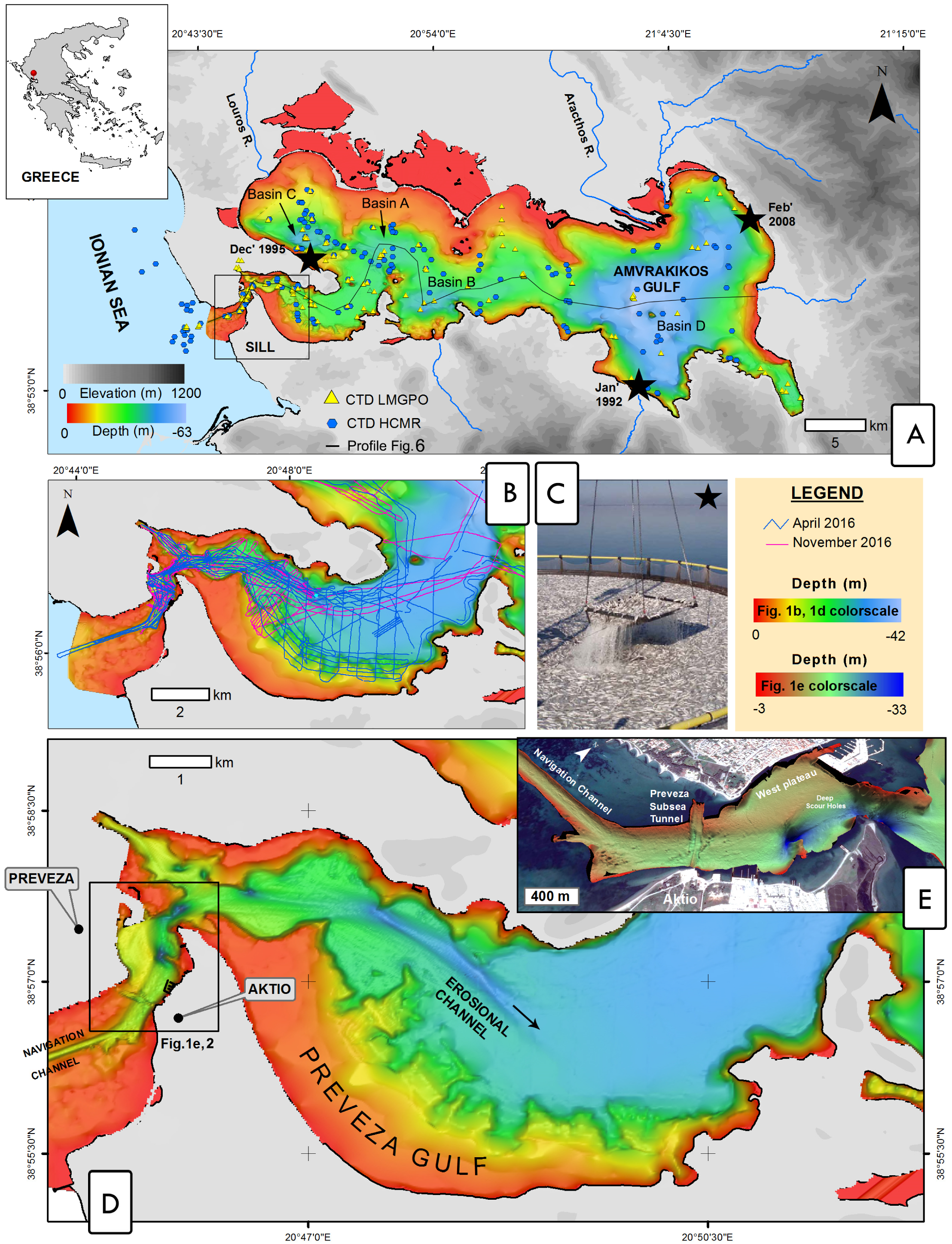
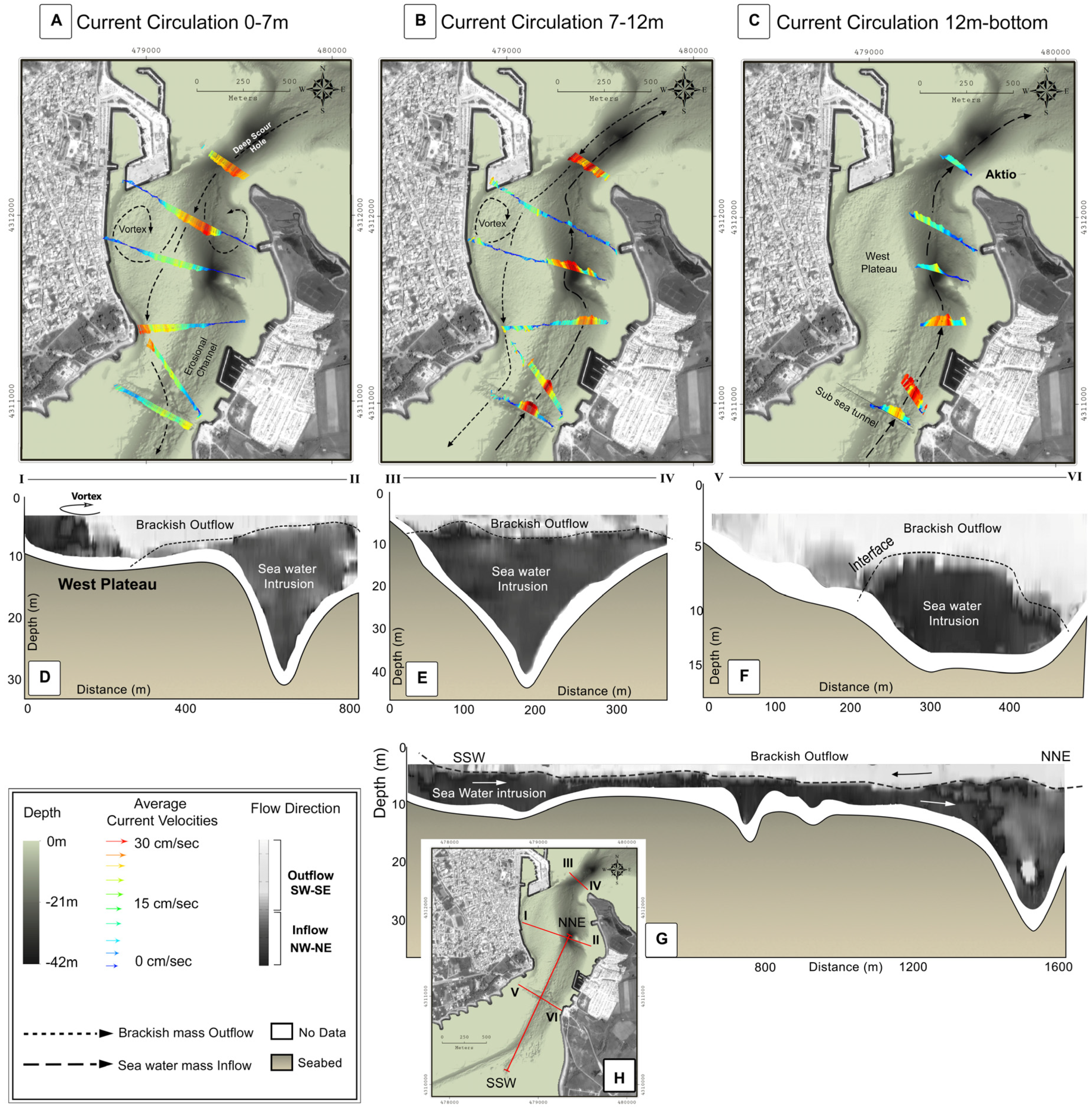
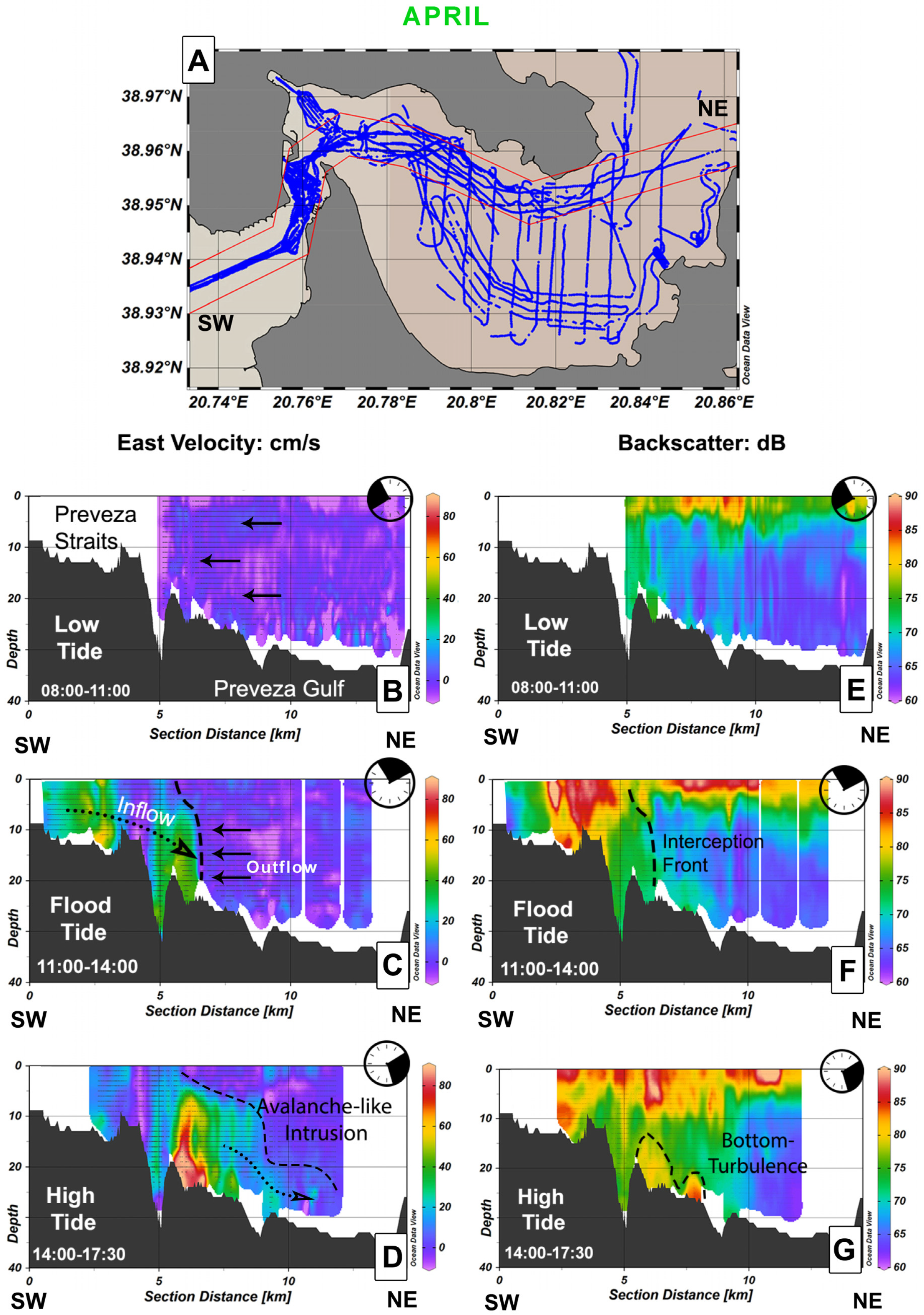
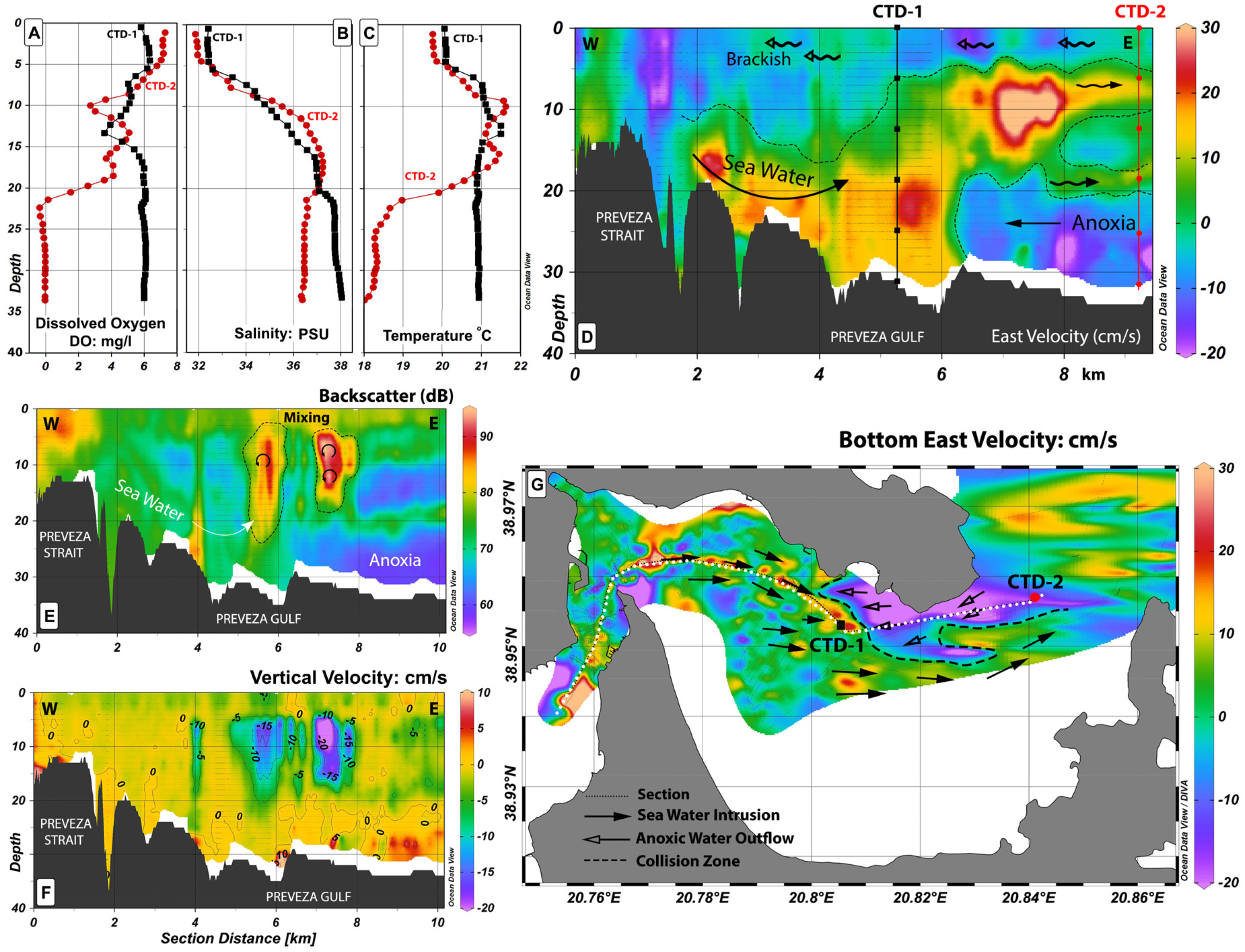
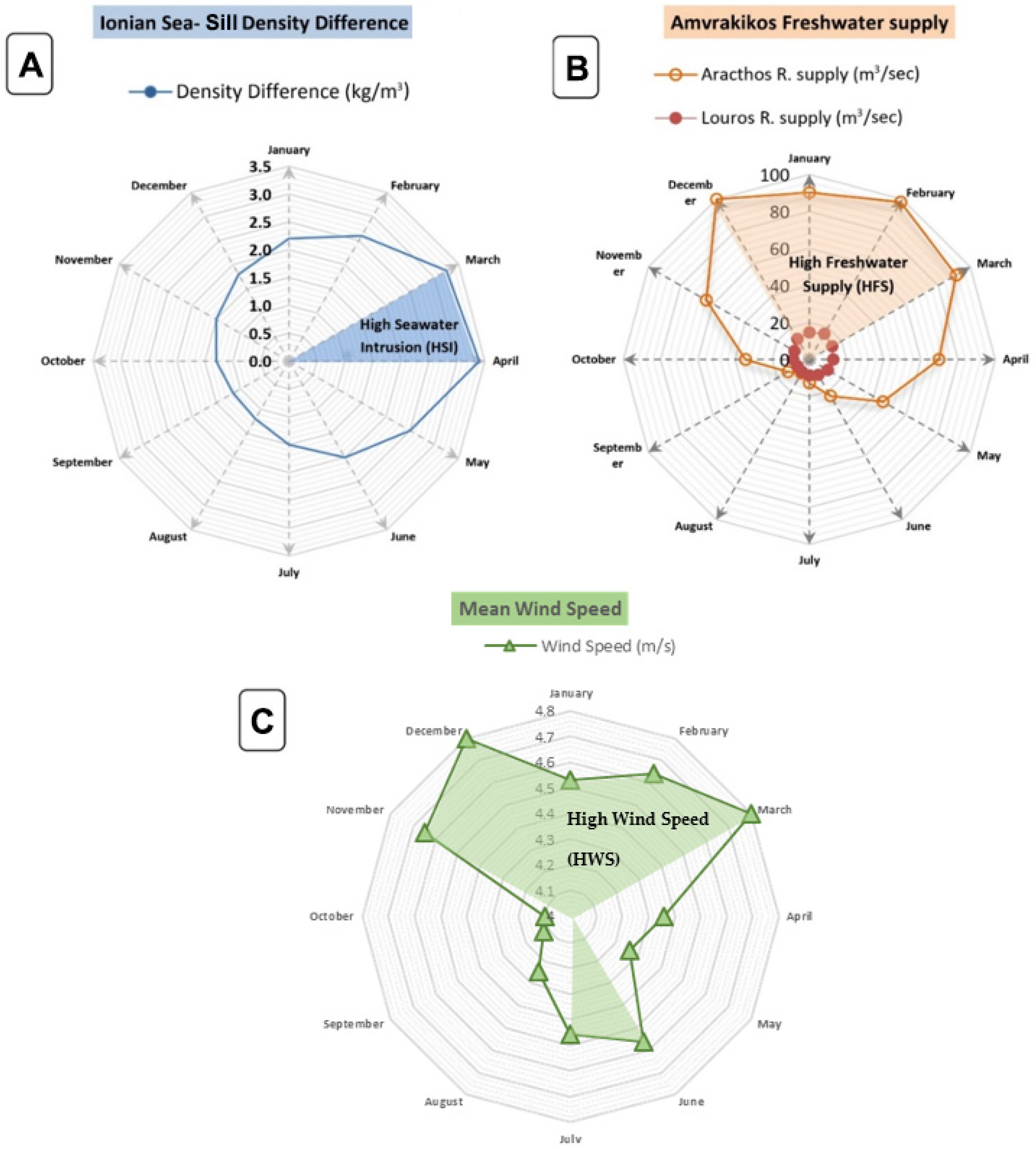
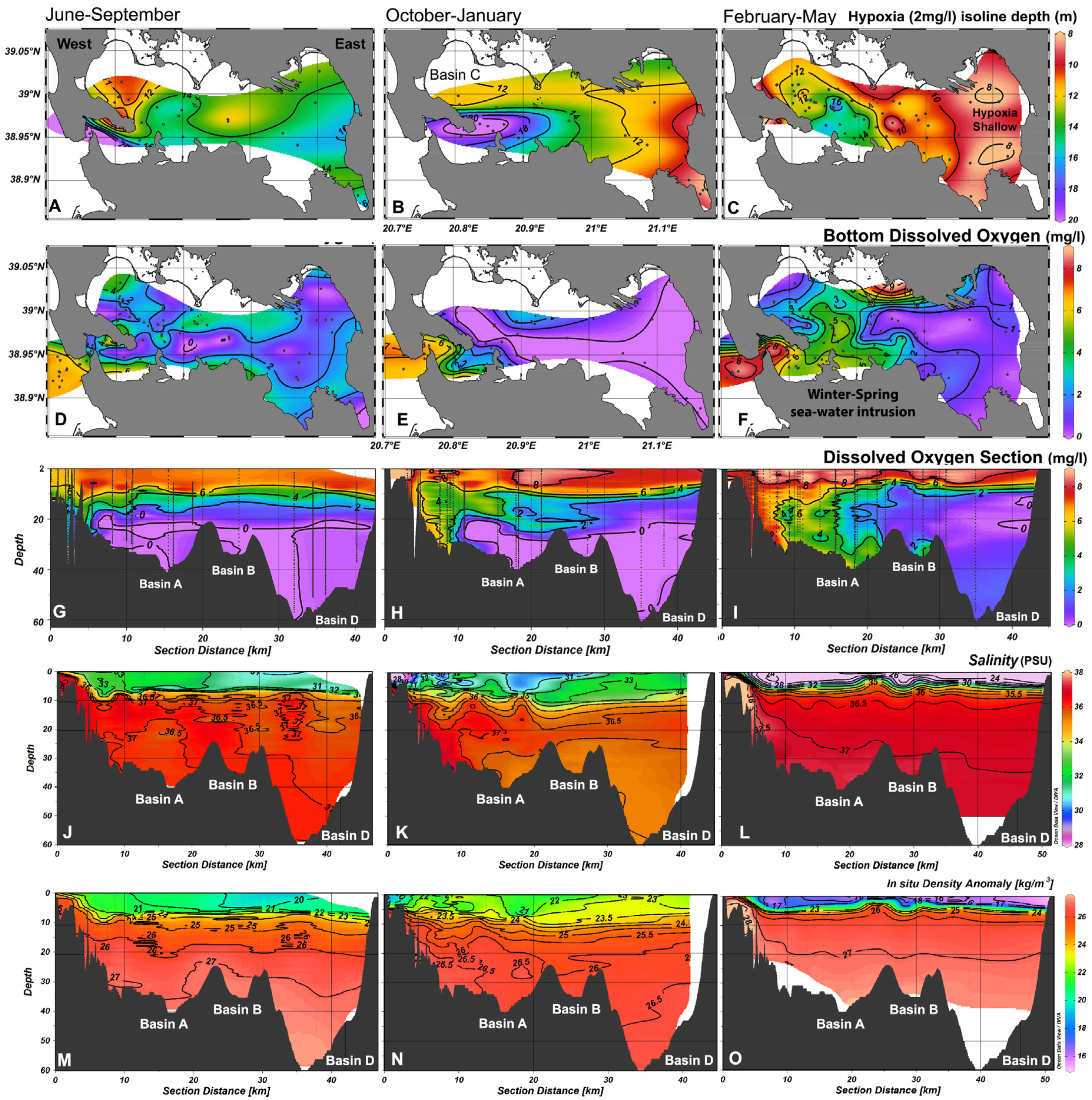
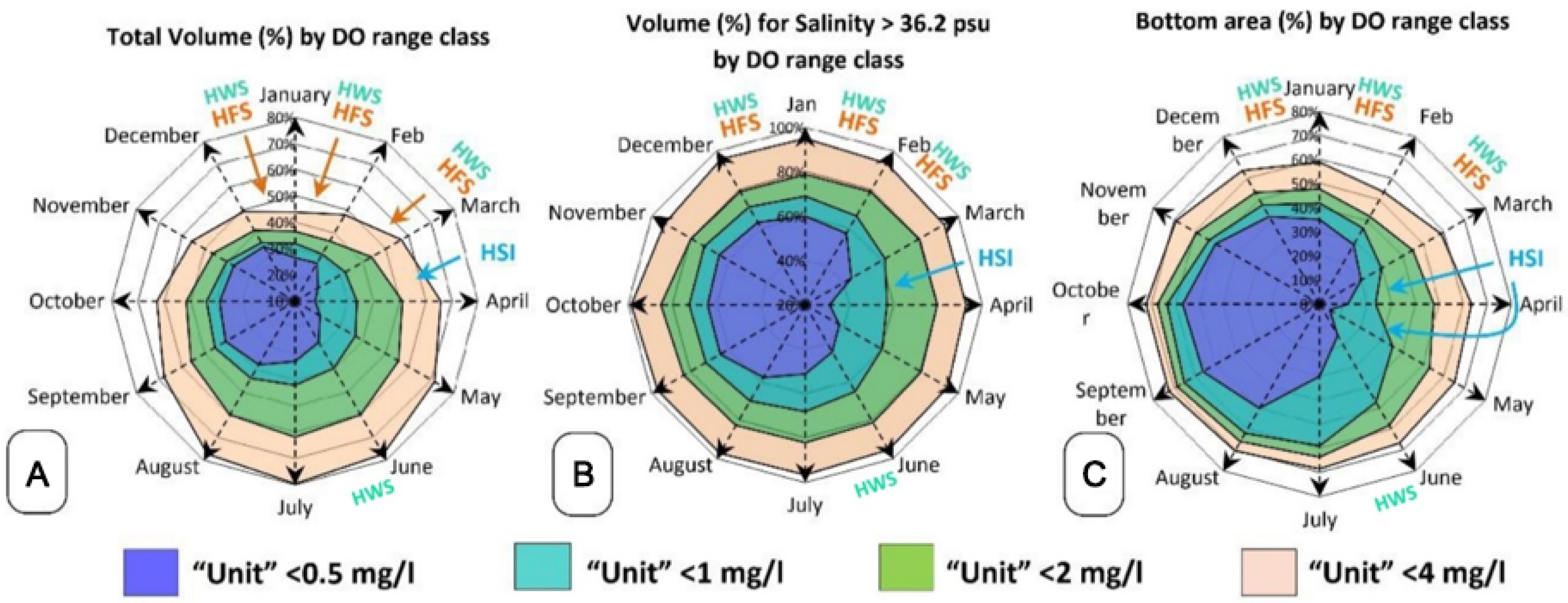
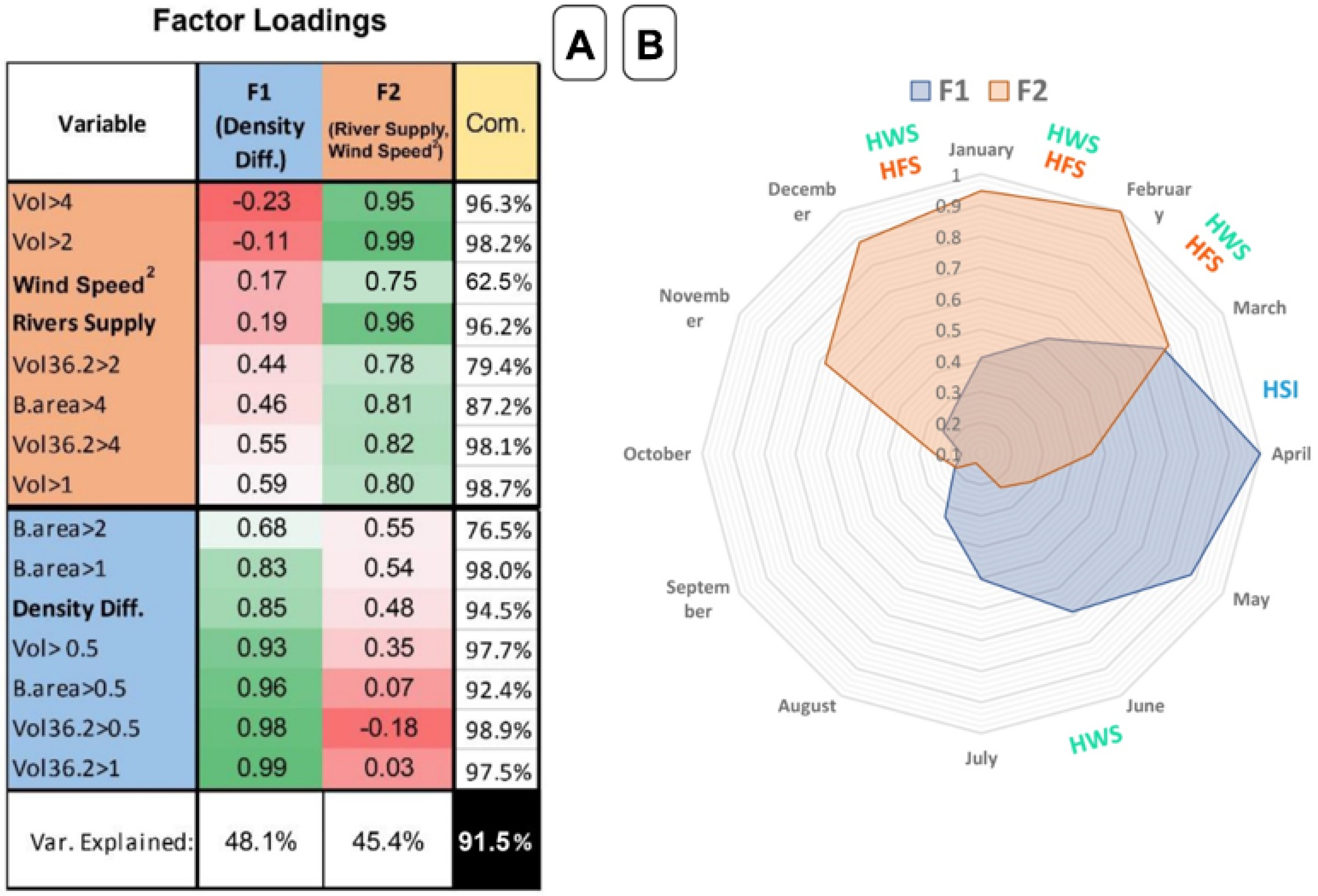
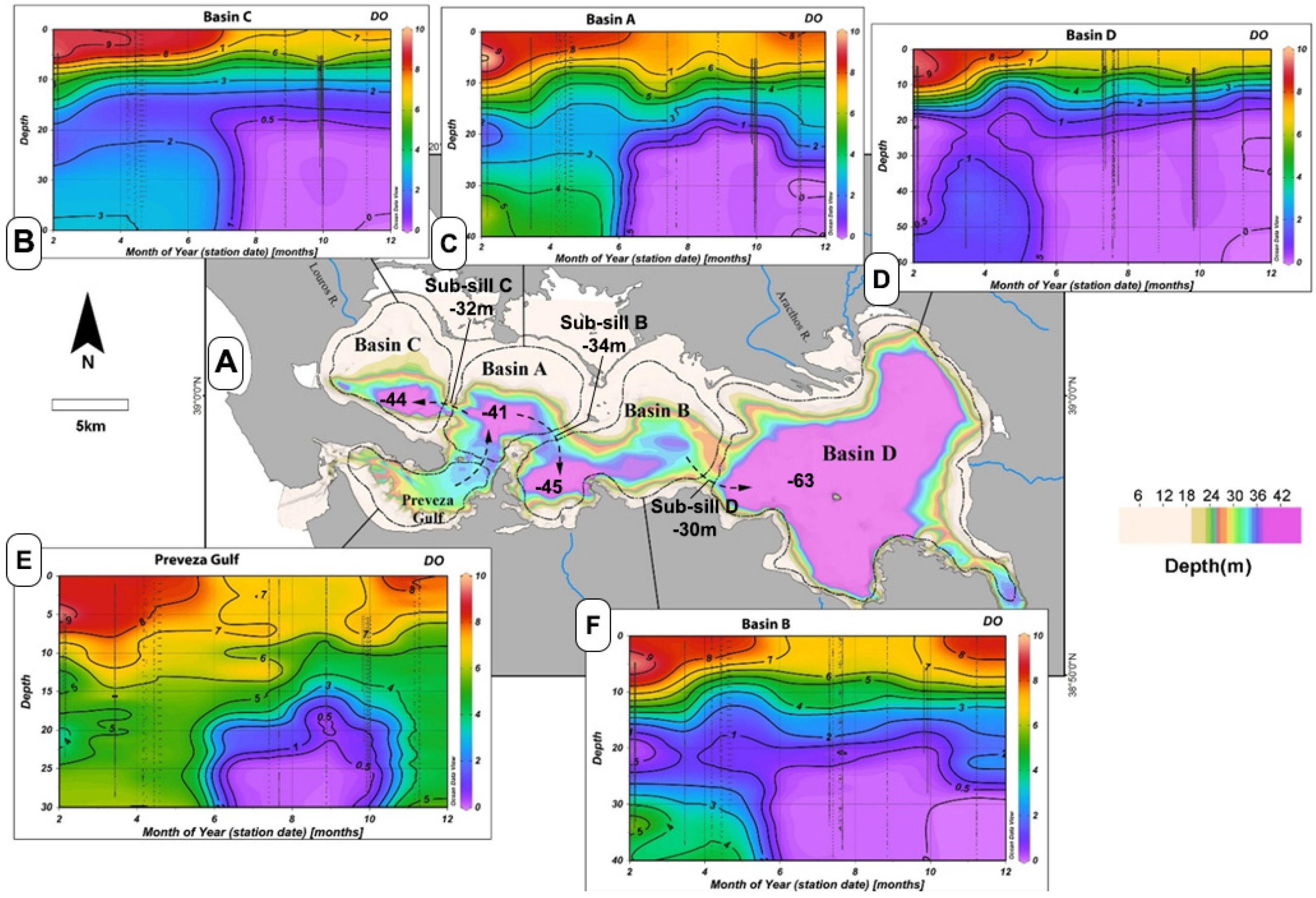
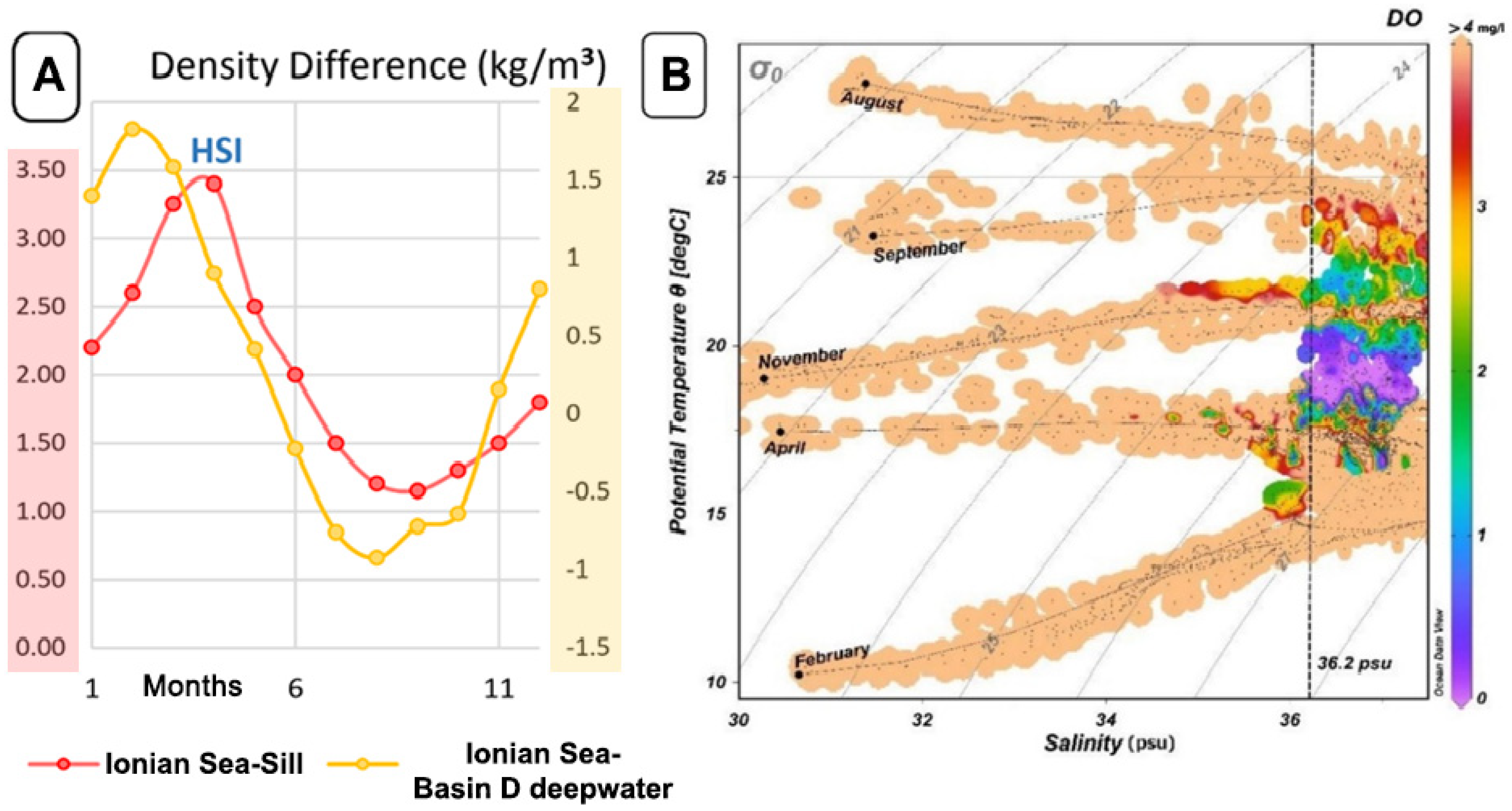
| Layer | Parameters (Unit) | Winter | Summer | Reference |
|---|---|---|---|---|
| Top (Brackish) | Salinity (PSU) | 11–22 | 31–33 | [27] |
| Temperature (°C) | 12–14 | 23.5–27/29 | [26,27] | |
| Dissolved oxygen (mg/L) | 7.5–9 | [14] | ||
| PH | 8 | [14] | ||
| Bottom (Saline) | Salinity (PSU) | 38–39 | 36–37 | [27] |
| Temperature (°C) | 15–16 | [26] | ||
| Dissolved oxygen (mg/L) | 2–6 | ≤2 | [14] | |
| PH | 7.6 | [14] | ||
Publisher’s Note: MDPI stays neutral with regard to jurisdictional claims in published maps and institutional affiliations. |
© 2021 by the authors. Licensee MDPI, Basel, Switzerland. This article is an open access article distributed under the terms and conditions of the Creative Commons Attribution (CC BY) license (https://creativecommons.org/licenses/by/4.0/).
Share and Cite
Georgiou, N.; Fakiris, E.; Koutsikopoulos, C.; Papatheodorou, G.; Christodoulou, D.; Dimas, X.; Geraga, M.; Kapellonis, Z.G.; Vaziourakis, K.-M.; Noti, A.; et al. Spatio-Seasonal Hypoxia/Anoxia Dynamics and Sill Circulation Patterns Linked to Natural Ventilation Drivers, in a Mediterranean Landlocked Embayment: Amvrakikos Gulf, Greece. Geosciences 2021, 11, 241. https://doi.org/10.3390/geosciences11060241
Georgiou N, Fakiris E, Koutsikopoulos C, Papatheodorou G, Christodoulou D, Dimas X, Geraga M, Kapellonis ZG, Vaziourakis K-M, Noti A, et al. Spatio-Seasonal Hypoxia/Anoxia Dynamics and Sill Circulation Patterns Linked to Natural Ventilation Drivers, in a Mediterranean Landlocked Embayment: Amvrakikos Gulf, Greece. Geosciences. 2021; 11(6):241. https://doi.org/10.3390/geosciences11060241
Chicago/Turabian StyleGeorgiou, Nikos, Elias Fakiris, Constantin Koutsikopoulos, George Papatheodorou, Dimitris Christodoulou, Xenophon Dimas, Maria Geraga, Zacharias G. Kapellonis, Konstantinos-Marios Vaziourakis, Alexandra Noti, and et al. 2021. "Spatio-Seasonal Hypoxia/Anoxia Dynamics and Sill Circulation Patterns Linked to Natural Ventilation Drivers, in a Mediterranean Landlocked Embayment: Amvrakikos Gulf, Greece" Geosciences 11, no. 6: 241. https://doi.org/10.3390/geosciences11060241
APA StyleGeorgiou, N., Fakiris, E., Koutsikopoulos, C., Papatheodorou, G., Christodoulou, D., Dimas, X., Geraga, M., Kapellonis, Z. G., Vaziourakis, K.-M., Noti, A., Antoniou, D., & Ferentinos, G. (2021). Spatio-Seasonal Hypoxia/Anoxia Dynamics and Sill Circulation Patterns Linked to Natural Ventilation Drivers, in a Mediterranean Landlocked Embayment: Amvrakikos Gulf, Greece. Geosciences, 11(6), 241. https://doi.org/10.3390/geosciences11060241










